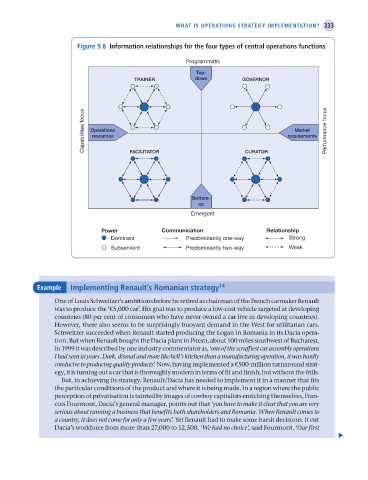Page 358 - Operations Strategy
P. 358
WHAT is oPERATions sTRATEgy imPlEmEnTATion? 333
Figure 9.8 Information relationships for the four types of central operations functions
Programmatic
Top-
Governor
Trainer
TRAINER down GOVERNOR
Capabilities focus Operations FACILITATOR CURATOR requirements Performance focus
Market
resources
Curator
Faciliator
Bottom-
up
Emergent
Power Communication Relationship
Dominant Predominantly one-way Strong
Subservient Predominantly two-way Weak
example Implementing renault’s romanian strategy 14
One of Louis Schweitzer’s ambitions before he retired as chairman of the French carmaker Renault
was to produce the ‘€5,000 car’. His goal was to produce a low-cost vehicle targeted at developing
countries (80 per cent of consumers who have never owned a car live in developing countries).
However, there also seems to be surprisingly buoyant demand in the West for utilitarian cars.
Schweitzer succeeded when Renault started producing the Logan in Romania in its Dacia opera-
tion. But when Renault bought the Dacia plant in Pitesti, about 100 miles southwest of Bucharest,
in 1999 it was described by one industry commentator as, ‘one of the scruffiest car assembly operations
I had seen in years. Dark, dismal and more like hell’s kitchen than a manufacturing operation, it was hardly
conducive to producing quality products’. Now, having implemented a €500-million turnaround strat-
egy, it is turning out a car that is thoroughly modern in terms of fit and finish, but without the frills.
But, in achieving its strategy, Renault/Dacia has needed to implement it in a manner that fits
the particular conditions of the product and where it is being made. In a region where the public
perception of privatisation is tainted by images of cowboy capitalists enriching themselves, Fran-
cois Fourmont, Dacia’s general manager, points out that ‘you have to make it clear that you are very
serious about running a business that benefits both shareholders and Romania. When Renault comes to
a country, it does not come for only a few years’. Yet Renault had to make some harsh decisions. It cut
Dacia’s workforce from more than 27,000 to 12,500. ‘We had no choice’, said Fourmont. ‘Our first
M09 Operations Strategy 62492.indd 333 02/03/2017 13:27

